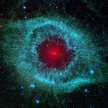The Earth’s Companion
Where did our only natural satellite come from?

British spelling.
The Moon.
Most scientists agree that our moon came into existence about 4.5 billion years ago.
It formed from ejected material thrown out into space when a planet roughly the size of Mars collided with the young Earth. It is also thought that the collision is the reason the Earth is tilted on its axis by over 23 degrees; this tilt is responsible for the different seasons we witness on our planet each year.
After all the ejected material came together, the moon ended up being 3,474 kilometres in diameter.
The young Moon was a lot closer to the Earth back then, orbiting at an estimated distance of 20,000 to 30,000 kilometres from the surface of our planet. Today, the distance between the Earth and the Moon is 384,400 kilometres.
If mankind had been around, then can you imagine how big the moon would have looked in the night sky?
At present, the Moon continues to move away from the Earth at 3.6 centimetres per year, which is roughly the speed your fingernails grow. In an average human life, that would be a distance of over 2.5 metres, which doesn’t seem much, but it shows how the kilometres would add up over millions or billions of years.
If we had no moon, our day would be roughly 6 hours long. The effect the moon has had on our tides has slowed down the Earth’s rotation over billions of years. And if there was no moon, the rise and fall of our tides would be significantly less, leaving only the gravity of the sun to pull at our oceans.

Photo by Marianne Heino on Unsplash
The largest tides occur when the Earth, the Moon, and the Sun are in alignment and both the Moon’s and the Sun’s gravity are pulling at our oceans at the same time.
Without the Moon, the evolutionary path for life on Earth may have been very different; we humans might have never existed.
On May 25, 1961, American President John F. Kennedy announced the ambitious goal of sending men safely to the moon and back. He said it would be achieved in less than ten years, but sadly, he was not there to see it happen within his estimated time scale.
I remember driving home one evening in July 1969, parking my car in the countryside, and looking up at the moon. It seemed so bright that night, I was amazed that two men had landed safely, left their spacecraft, and were walking on the moon’s surface.
I felt so proud of humanity and so privileged to have been born at the right time to witness and understand that great event.
Apollo 11 was the first spacecraft to take men to the Moon; it arrived there on July 20, 1969.
Three men made that journey: Michael Collins flew the command module Columbia, and he stayed up there orbiting the moon while Neil Armstrong and Buzz Aldrin made their way to the surface in the lunar module Eagle. It must have been a very long day for Michael; his biggest fear was the real possibility of going home alone.
A moon is a natural satellite that can orbit planets, dwarf planets, and, surprisingly, asteroids. Counting all the planets in the solar system, there are altogether 285 confirmed moons.
Not counting shepherd moons, the smallest of them all is Deimos, a moon that orbits Mars; its diameter is only 12.4 kilometres.
Among all the moons in the solar system, Jupiter’s moon Ganymede is the biggest by far. Including the Sun; it is the ninth-largest object in the Solar System. Surprisingly, the planet Mercury is smaller than Ganymede.
Unlike Mercury and Venus, which have no moons, Earth has one moon. Mars has 2 moons, Jupiter has 95, Saturn has 146, Uranus has 27, and the most distant planet, Neptune, has 14 moons.
The end.
_
If you found my article interesting and educational then please go to my profile for more. Regards.
About the Creator
A B Forbes
Someone with a lifelong passion for that gargantuan area we call the universe. I also write stories about life itself. Enjoy






Comments
There are no comments for this story
Be the first to respond and start the conversation.